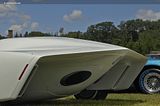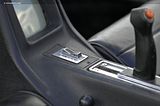To truly appreciate GM's Astro III concept, you've got to view it through 1969 eyes. NASA's space program was the envy of the world, having reached the moon. Transistors were replacing tubes in radios and jets were replacing prop-driven commercial aircraft. High-tech and space age reigned.
The sleek, gas turbine–powered 1969 Chevrolet Astro III two-seater foreshadowed alternative powertrains and advanced automotive technology. The turbine weighed just 139 pounds but cranked out 317 hp. The wide-set rear wheels and narrow-track front wheels foresaw the DeltaWing racer by four decades. The Astro III's closed-circuit TV rearview mirrors and drive-by-wire steering also show the concept's advanced thinking, as did the powered and cantilevered forward-opening canopy.
Bill Mitchell's breathtaking 1967 Astro I styling study enabled his designers to explore the boundaries between beauty and low-drag forms. At less than three feet high, it was the lowest concept model ever created by GM design, so low that passengers had to use elevator seats to get in and out. A touch of a flush release pad caused the canopy to rise electrically. Once inside, occupants were lowered to a reclining position with another button.
By contrast, the following year's Astro II, a collaboration between GM Design and GM Research, was a much more production-practical sports car. One of an extended series of mid-engine concepts created by Mitchell and Corvette Chief Engineer Zora Arkus-Duntov, with input from Larry Shinoda, it was designed with future Corvettes in mind.
The radical 1969 Astro III is a two-passenger experimental car resembling an executive jet aircraft, even down to its 'tricycle' wheel arrangement....though it actually has four wheels, with the front pair placed close together under its nose. Powered by a Model 250-C18 gas turbine engine, it was envisioned as a high-performance vehicle suited for future restricted access or system-controlled highways. A power canopy moves forward and upward for entry, and rear vision is provided by closed-circuit TV with a screen on the center console. Most driving controls are operated by pistol grip levers in place of a conventional steering wheel.
The gas turbine is placed behind the passengers and propels the rear wheels by means of a two-speed Hydra-Matic transmission. It is a Type 250-C18 gas turbine made by Allison Division of General Motors. This particular gas turbine weights only 62 kg (139 lbs.) and produces 317 hp. It is produced for the propulsion of civil and military helicopters.
Overall dimensions for the Chevrolet ASTRO III are 1030 mm (40,5 inches) in height, 4970 mm (195,6 inches) in length, 2020 mm (79,5 inches) in rear width and 2380 mm (93,7 inches) for the wheelbase. The weight with two passengers on board is announced for 892 kg. (1966 lbs.)
|
1969 Chicago Auto Show
|





